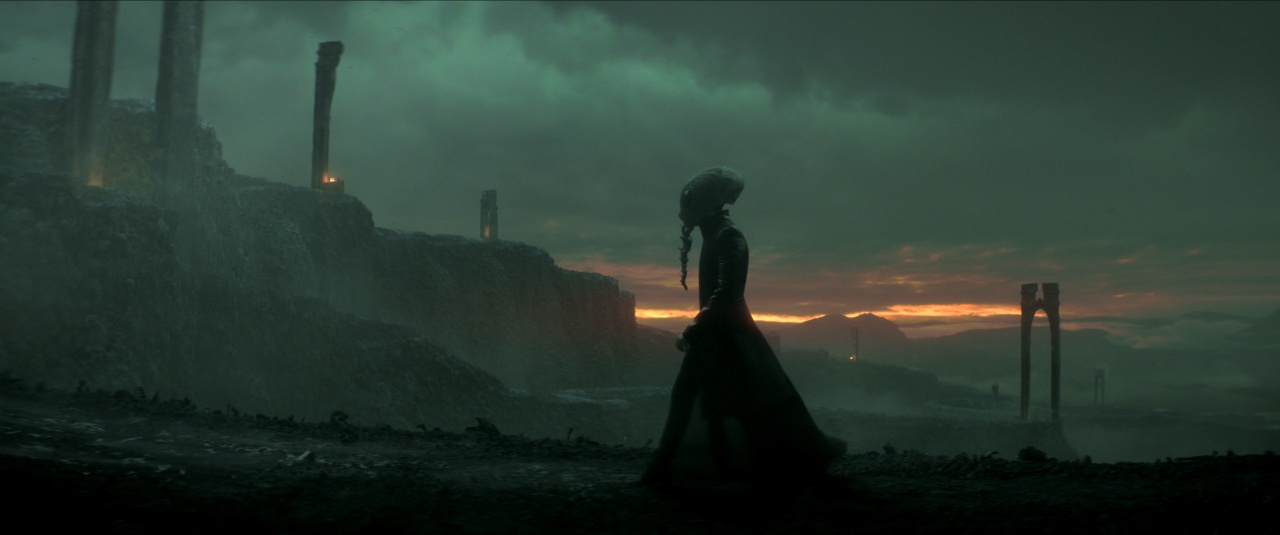Tom Sturridge as Dream | Courtesy Of Netflix © 2025
As Netflix’s adaptation of The Sandman begins its final season, the groundwork is laid for what’s sure to be a tragedy that would rival the very best of Greek tragedies. Eschewing some of the lallygagging, lackadaisical pacing that permeated its first season, season two of The Sandman tells a taut, tightly-paced tale of betrayal, redemption, and consequences. As Morpheus grapples with the action of past sins, he must place his very life on the line to make amends. While fans of the comic may mourn some of the stories left on the cutting room floor, season two of The Sandman greatly benefits from its streamlined focus, resulting in an enthralling family drama with hints of delicious, melodramatic tragedy on the horizon.
A Journey Into Hell
Picking up where the first season left off, Dream (Tom Sturridge) journeys to Hell to rescue an old lover he damned to an eternity in the fiery pit. But what he uncovers sends Dream down a path that may just lead to his undoing. For though the road Dream walks may lead him to redemption, it may also spell the end of everything he holds dear. It’s a path that reunites him with lost loves and lost family as the Lord of Dreams realizes just how much he’s changed after spending a century trapped on Earth. Adapting storylines originally found in volumes 4 and 7 of the comics, the first half of The Sandman‘s second and final season tells a more streamlined story of betrayal, heartbreak, and forgiveness. Put simply, if you liked The Sandman‘s first season, you’re gonna adore its second.
Everything that worked about season one returns in season two. You’ve got Tom Sturridge’s haunting portrayal of Dream, alongside his ever-expanding family, featuring the return of Kirby Howell-Baptiste, Mason Alexander Park, and Donna Preston as Death, Desire, and Despair. Joining them are Adrian Lester, Esmé Creed-Miles, and Barry Sloane as Destiny, Delerium, and Destruction (the missing Endless sibling). As season two unfolds, it quickly becomes apparent that Dream’s story is far bigger and stranger than what we saw in season one, with ties all the way back to Ancient Greece and the myth of Orpheus and Eurydice. And as Dream grapples with his past sins, Destiny foretells a dangerous future for Dream—one that he just might not escape. It’s the beginning of The Sandman‘s final outing, and these first six episodes promise quite a doozy of an ending.

A Tighter Focus But at What Cost?
Perhaps the biggest change between seasons of The Sandman lies in its structure. Season two takes a page out of Andor’s second season, with this first half of the season being comprised of two distinct arcs, each spread across three episodes adapting “Season of Mists” and “Brief Lives”, respectively. As such, though each arc feels nice and contained and far more focused than season one’s storylines felt, the whole show feels as though it’s moving at a breakneck speed. Though focused more squarely on Dream’s journey proves to be a much-needed boon, it comes at the cost of the quieter, more character-focused stories found in season one—like “The Sound of Her Wings”, the season’s sixth episode. Though the season does make room for some beloved standalone stories, like “A Midsummer Night’s Dream”, “The Song of Orpheus”, and “Thermidor”, tying them tighter into Dream’s overarching story than the comics might’ve.
That being said, these episodes still find time to delve into Dream’s relationships—most notably with his sister, Delerium, and his son, Orpheus (Ruairi O’Connor). O’Connor’s performance as Orpheus is equal parts breathtaking and heartbreaking, as is his relationship with Dream. But it’s Delerium that both makes and breaks this half of the season. Her longing for reuniting with Destruction sends Dream down this path of redemption and her relationship with Dream offers up the most tender scenes found in the season so far. But translating her from page to screen proves a bit difficult as, despite some strong writing and Creed-Miles’ equally strong performance, the show can’t quite capture the otherworldliness of Delerium’s page counterpart. Still, this trio’s relationship is where The Sandman really starts finding its footing as a story about redemption and the power of storytelling.

The Elephant in the Room
And now for the elephant in the room. When discussing any adaptation of Neil Gaiman’s works, it must be acknowledged that earlier this year, multiple credible allegations of sexual assault were levied against Gaiman, resulting in both the cancellation of some adaptations of his work as well as the major retooling of others, such as Amazon Prime’s ongoing adaptation of Good Omens. As far as The Sandman is concerned, co-executive producers, Allan Heinberg and David S. Goyer, both report that the decision to end the series with its second season was made long before the allegations against Gaiman came to light and that Gaiman, himself, played a far smaller role on the show’s second season than he did on its first.
However, it remains difficult to separate Gaiman from The Sandman. For so long, it’s been identified solely in connection with Gaiman, and many of its themes read a bit differently in the wake of these allegations than they previously did. Still, the vast majority of production on season two occurred before the surfacing of the allegations against Gaiman, leaving The Sandman in a sort of twilight zone in-between space. Your mileage may vary on whether you want to support the show given the allegations against its creator, It’s a decision every viewer must make for themselves, given the situation surrounding the show, its production, and the timing of its airing. Though the show’s marketing does its best to distance itself from Gaiman, much to its credit, the fact of the matter still remains and may prove ultimately inescapable.
Final Thoughts
Setting all of that aside, the first half of The Sandman‘s second and final season holds onto much of what fans enjoyed in its first season while delivering a tighter, more focused narrative. Sure, it sometimes feels as though the show is speedrunning its way through the last 50 or so issues of The Sandman‘s original comic run, desperate to reach its climactic conclusion as quickly as possible. But mostly, it works, even if the series might’ve been better splitting up each arc into their own separate volume like Andor did, rather than releasing both “Season of Mists” and Brief Lives” at the same time.
As a fantasy show standing on its own two legs, the first half of The Sandman‘s second season is about as strong of a beginning as you could hope for. Its pacing feels a bit too breakneck in the latter three episodes, but it’s a far more efficient and, surprisingly, faithful adaptation of the comics, sticking to its core themes and arcs without wandering too far astray. If the latter five episodes, set to debut July 24th, can stick the landing, then Netflix might just have achieved the previously unthinkable: a complete adaptation of the once unfilmable Sandman series.
Season Two, Volume 1 of The Sandman premieres July 3rd on Netflix, with volume 2 following on July 24th and a subsequent bonus episode airing on July 31st

Netflix's adaptation of "The Sandman" returns with a group of episodes that are far more focused and tightly paced, resulting in a more efficient and accurate adaptation of the source material. Led by Sturridge's haunting performance, as well as some strong turns from newer cast members Barry Sloane and Esmé Creed-Miles, the first half of The Sandman's second season promises an epic of tragic proportions.
-
GVN Rating 8
-
User Ratings (2 Votes)
8




![‘Jay Kelly’ Review – Noah Baumbach Makes A Case For The Magic Of Movie Stardom [NYFF 2025] ‘Jay Kelly’ Review – Noah Baumbach Makes A Case For The Magic Of Movie Stardom [NYFF 2025]](https://cdn.geekvibesnation.com/wp-media-folder-geek-vibes-nation/wp-content/uploads/2025/11/Jay-Kelly-JKELLY_20240523_15320_C2_R-300x180.jpg)

